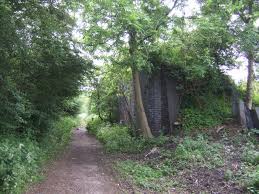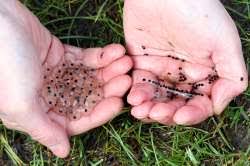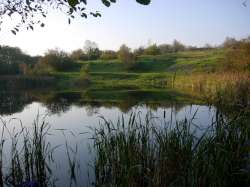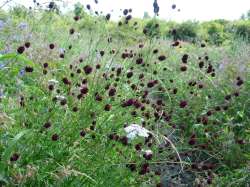Spring and summer are fantastic times to wander around Fibbersley, as the spring means that the amphibians are really active. Spring is the mating season for frogs and toads, and the males are actively looking for females - you may even see males (sometimes many males!) clasped onto the female in hopes of mating. This grasp is called 'amplexus', and often results in giant 'balls' of toads! Toads even have special areas called 'Nuptual Pads' on their thumbs to help them keep a good grip on their girl!
Spring is a great time to keep an eye out for frog and toad spawn - you can tell the difference easily, as frogs lay spawn in clumps of jelly that look like bubbles, and toads lay their eggs in strings! Take a look at the example pictured below:
Newtopia!
Its not just frogs and toads that enjoy the watery paradise at Fibbersley - it is one of a few very special sites in walsall that is home to the rare Great Crested Newt, a protected species. The law protects these spectacular amphibians and the pools in which they live, so its actually illegal to touch one unless you have a special licence! If you fancy 'meeting' a great crested newt, why not come along to a pond dipping day where you'll get the chance to have a close encounter with these secretive and spectacular creatures!
Other Wildlife
Its not only pond life that thrives at Fibbersley. Over 200 different plant species and more than 20 species of birds have been recorded here! Grey herons take advantage of the access to tasty frogs and newts, mute swans and lesser whitethroats are regular visitors. Kestrels can also be seen flying above the nature reserve. It is also a spectacular place in the summer to see butterflies and dragonflies!
History
We are continually facing the loss of countryside to development. However, at Fibbersley Local Nature Reserve the reverse is the case. A hundred years ago, the sites and sounds here would have been those of heavy industry, in particular iron and steel work. Coal mines, foundaries and canals dominated the whole area.
The deep mines here closed at the end of the nineteenth century, to be replaced with clay and sand quarries. From 1872 to 1931 a railway line crossed the site and carried passengers and freight between Walsall and Wolverhampton. This ran east to west, whilst a mineral line ran north to south to carry coal and clay etc. When it opened in 1887, the Bentley canal linked the area with the regional canal netwrok.
Today, at first glance there is little evidence of this industrial activity. However, on site there are disused railway tracks, ponds on the site of capped mineshafts, and flooded quarry pits. Broom now flouises on the coal spoil mounds which divide the wildflower meadows from the marshes.
The site has now become so important for wildlife and the people of the area, that it has been declared a Local Nature Reserve which should ensure its protection for years to come.
Newtopia





